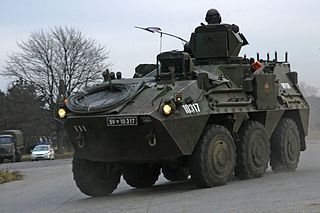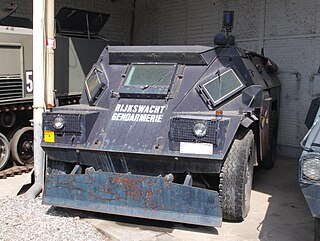Operators

| Akrep | |
|---|---|
| Type | Infantry mobility vehicle |
| Place of origin | Turkey |
| Service history | |
| In service | 1994 |
| Wars | |
| Production history | |
| Designer | Otokar |
| Designed | 1990 |
| Manufacturer | Otokar |
| Produced | 1994 |
| Variants | developed from Land Rover Defender 130 |
| Specifications | |
| Mass | 3.6 t (3.5 long tons; 4.0 short tons) |
| Length | 4.19 m (13 ft 9 in) |
| Width | 1.91 m (6 ft 3 in) |
| Height | 2.563 m (8 ft 4.9 in) |
| Crew | 2+6 |
Main armament | 7.62 mm or .50 inch machine gun on remote weapon station |
| Engine | diesel |
| Suspension | 4x4 |
Akrep ("Scorpion") is a Turkish infantry mobility vehicle developed by Otokar Otobus Karoseri Sanayi AS. The first prototypes were completed in May 1993 and the first vehicles came off the production line in June 1994. In addition to light reconnaissance, the vehicles were used for escort, perimeter control, counterinsurgency, and light attack. The Akrep represented the latest offering in Otokar's portfolio of light vehicles for both civilian and military markets. [1]
The Akrep has an all-welded steel hull with some 70%[ citation needed ] of its automotive components used from the Land Rover Defender 90/110 (4x4) vehicle. A monocoque steel armor hull protects from small arms fire up to 7.62 mm ball ammunition fired at 90° incidence and point-blank range, and shell splinters. All windows and vision blocks are made of laminated construction armored glass with a polycarbonate liner. The layout is conventional, with the engine at the front, driver and commander in the center, and the machine gun installation mounted on the roof toward the rear with the gunner seated below. The windshield is bulletproof. There are two doors with bulletproof windows at the top and firing ports below. There are also firing ports and viewers[ jargon ] on both sides of the hull and a large rear hull door with a firing port that swings out leftward. There is a hatch in the rear section of the roof that opens rearward. The roof gun mount is typically armed with a 7.62 mm machine gun that may be aimed and fired from inside the vehicle. [1] Also there is AGS-17 mounted variants being used in Northern Cyprus.
The mount can traverse 180° left and right and the 7.62 mm machine gun can elevate from -20° to +70°. There are 230 rounds of ready-use ammunition, and an additional 3,000 rounds carried inside the vehicle. The firing is electronically controlled with safety locking and braking together with a mechanical backup. There is also a last round indicator. The day sight has a wide field of view (22°) with 1x magnification and a collimated aiming circle, and a narrow field of view (8°) with 8x magnification and a ballistic graticule. The night sight has a wide field of view (22°) with 1x magnification and collimated aiming circle, and a narrow field of view (7°) with 7x magnification, a 25 mm image intensifier tube, and a ballistic graticule. Standard equipment includes an air conditioning system, a heater and defogger, an infrared driving headlamp, a blackout lighting system, a smoke extraction fan mounted on the roof, thick polyurethane roof and body interior lining for thermal and noise insulation, an explosion-suppressed fuel tank, and Hutchinson run-flat tires. Optional equipment includes a front-mounted electrical winch with 25 meters of cable at a capacity of 3,600 kg, 66 mm smoke grenade launchers, a pioneer kit (axe, shovel, pickaxe), a communications system, and a land navigation system. [1]
The Akrep is relatively light, fast, and maneuverable. Its high power/weight ratio and long travel suspension support mobility in urban conditions, rough terrain, and challenging weather. [1]
The Akrep's low profile, ballistic hull design and special armor protection and agility are all designed to maximize its ability to survive in high-threat environments.[ citation needed ] Each armor plate is laboratory tested and certified. Each panel is stamped prior to production and fully traceable. [1]
All mechanical parts of Akrep are made using commercial off-the-shelf components. [1]


The BMP-1 is a Soviet amphibious tracked infantry fighting vehicle, in service 1966–present. BMP stands for Boyevaya Mashina Pyekhoty 1, meaning "infantry fighting vehicle, 1st serial model". The BMP-1 was the first mass-produced infantry fighting vehicle (IFV) of the Soviet Union. It was called the M-1967, BMP and BMP-76PB by NATO before its correct designation was known.

The M48 Patton is an American first-generation main battle tank (MBT) introduced in February 1952, being designated as the 90mm Gun Tank: M48. It was designed as a replacement for the M26 Pershing, M4 Sherman, M46 and M47 Patton tanks, and was the main battle tank of the U.S. Army and U.S. Marine Corps in the Vietnam War. Nearly 12,000 M48s were built, mainly by Chrysler and American Locomotive Company, from 1952 to 1961. The M48 Patton was the first U.S. medium gun tank with a four-man crew, featuring a centerline driver's compartment and no bow machine gunner. As with nearly all new armored vehicles it had a wide variety of suspension systems, cupola styles, power packs, fenders and other details among individual tanks.

Nashorn, initially known as Hornisse, was a German Panzerjäger of World War II. It was developed as an interim solution in 1942 by equipping a light turretless chassis based on the Panzer III and Panzer IV tanks with the 8.8 cm Pak 43 anti-tank gun. Though only lightly armoured and displaying a high profile, it could penetrate the front armour of any Allied tank at long range, and its relatively low cost and superior mobility to heavier vehicles ensured it remained in production until the war's end.

The BRDM-2 is an amphibious armoured scout car used by states that were part of the Soviet Union and its allies. It was also known under the designations BTR-40PB, BTR-40P-2 and GAZ 41-08. This vehicle, like many other Soviet designs, has been exported extensively and is in use in at least 38 countries. It was intended to replace the older BRDM-1, and has improved amphibious capabilities and better armament compared to its predecessor.

The AIFV is a US tracked light armored vehicle that serves as an infantry fighting vehicle (IFV) in the armies of several countries. It is a development of the M113A1 armored personnel carrier.

The BTR-4 "Bucephalus" is an amphibious 8x8 wheeled infantry fighting vehicle (IFV) designed in Ukraine by the Kharkiv Morozov Machine Building Design Bureau.
A huge number of M113 Armored Personnel Carrier variants have been created, ranging from infantry carriers to nuclear missile carriers. The M113 armored personnel carrier has become one of the most prolific armored vehicles of the second half of the 20th century, and continues to serve with armies around the world in many roles.

The Dragoon 300 AFV was produced by Arrowpointe Corporation during the 1980s. It was based on the automotive components of the United States Army's M113 APCs and 5-ton trucks. It resembles a larger V-150 Commando.

Lahko kolesno oklepno vozilo Valuk is an improved version of Pandur 6X6 APC, manufactured under a license manufacturing agreement with the Austrian company, Steyr Daimler Puch Spezialfahrzeug AG & Co KG, by Sistemska Tehnika of Slovenia for the Slovenian Army.

The Cobra is a family of armored vehicles produced by Otokar of Turkey. It is produced in two generations.
The Mohafiz is a family of internal security vehicles designed and manufactured by Heavy Industries Taxila with Cavalier Group also designing later production models.

The Type 85 is a tracked armoured fighting vehicle produced by Chinese company Norinco. It is an improved version of the Type 63 armoured personnel carrier. The vehicle is bigger, has additional firing ports and periscopes, a longer chassis with an additional road wheel on each side, and is equipped with an NBC protection system.

The Fahd is a 4x4 Egyptian armored personnel carrier, designed to fit the requirements of the Egyptian Military. It replaced older APCs in Egyptian service such as the BTR-40, and the Walid. It has been used by the United Nations.

The BMP series were among the first production line infantry fighting vehicles. Included in the series are the mainline BMPs, the airborne variant BMDs, and licensed modified and reverse engineered versions. BMP stands for Boyevaya Mashina Pekhoty, meaning "infantry fighting vehicle". They were initially developed in the 1960s in the Soviet Union.

Otokar Arma is a 6x6 and 8x8 amphibious wheeled armored combat vehicle family designed and developed by Otokar. The vehicle is a modular multi-wheel configurable with a monocoque steel hull.

BMC Kirpi is a Turkish made Mine-Resistant Ambush Protected vehicle manufactured by BMC. Kirpi provides significant protection against mine and ballistic threats. It combines standard and add-on armor providing protection against ballistic threats. Its V-shape underbody and monocoque allows it to protect the personnel inside from land mines and improvised explosive devices (IEDs).

The BOV M16 Miloš is a Serbian 4x4 multipurpose armoured vehicle (MPAV) used for military and law enforcement applications. It features a V-hull, integrating floating-floor plates, and blast-mitigation seating to protect occupants against land mines and improvised explosive devices (IEDs). The M16 Miloš was first publicly presented at IDEX 2017 exhibition in Abu Dhabi, UAE.

The Vickers Main Battle Tank Mk. 3 is a main battle tank by Vickers, a development of the Vickers MBT, and introduced in 1975 for the export market. It was the last of the Vickers tanks to see sales in numbers abroad.
AKREP II JPG. Akrep II is a Turkish multi-role vehicle produced by Otokar. There were 2 main types of Akrep II, the electric-drive type is called Akrep IIe, and the diesel-drive type is called Akrep IId. A hybrid-drive version is planned. The vehicle can also be configured as a weapon platform for quick reaction, surveillance missions, armored security, base/air defense missions and other similar missions.

The Timoney armoured personnel carrier refers to a series of armored personnel carriers developed by Timoney Technology Limited of Ireland in the 1970s and 1980s.